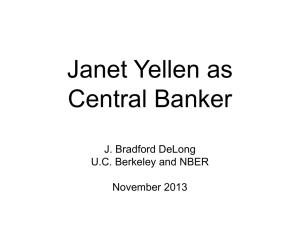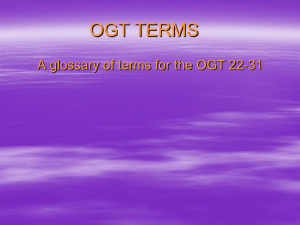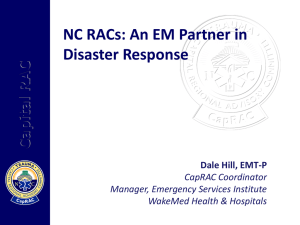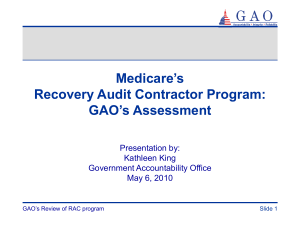Two markets
advertisement
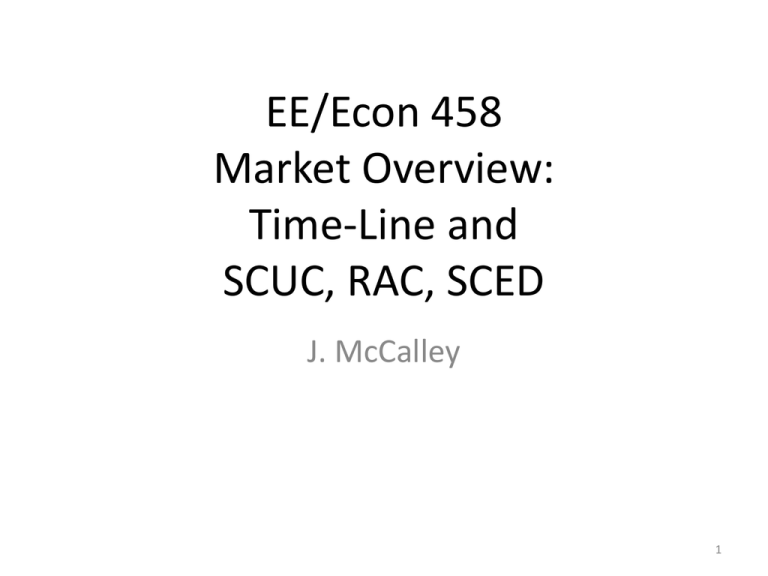
EE/Econ 458 Market Overview: Time-Line and SCUC, RAC, SCED J. McCalley 1 Market time line Operating day commences. RAC process closes; new units notified. 2000 0000 Ref: A. Botterud, J. Wang, C. Monteiro, and V. Miranda “Wind Power Forecasting and Electricity Market Operations,” available at www.usaee.org/usaee2009/submissions/Onl 2 ineProceedings/Botterud_etal_paper.pdf Two markets and a process The next slide is divided into three columns, one each for • Day-ahead market, • Reliability assessment commitment process, and • Real-time market For each column, there are two main sections. • The upper section, in dark blue, yellow, and green, say what its name is (dark blue), what kind of market it is (yellow), and what it does (green). • The lower section, in light blue and pink, identifies the software applications used within the function, either SCUC (light blue) or SCED (pink). 3 Two markets and a process DAY-AHEAD MARKET REAL-TIME MARKET (DAM) The Day-Ahead Energy and Operating Reserve Market is a financially binding market that clears energy, reg reserve, spin reserve & supp reserve hourly. SC-SCUC commits resources, schedules regulating reserves on committed resources and/or releases emergency operating ranges on resources. SC-SCED is used to clear/price energy, regulating reserve, spinning reserve and supplemental reserve on hourly basis. Reliability Assessment Commitment Process (RAC) The Reliability Assessment Commitment (RAC) process is a process to commit resources, schedule regulating reserve on committed resources and/or release emergency operating ranges on resources when appropriate, hourly for use in the Real-Time Energy and Operating Reserve Market. The RAC process can be executed on a multi-day, day-ahead and/or intra-day basis. SC-SCUC is used in the RAC process to commit resources, schedule regulating reserves on committed resources and/or release emergency operating ranges on resources for the Real-Time Energy and Operating Reserve Market. Ref: M. Tackett, Experience with Implementing Simultaneous Co-optimization In The Midwest ISO Energy & Operating Reserve Markets, IEEE PES General Meeting, 2009. (RTM) The Real-Time Energy and Operating Reserve Market is a financially and physically binding market that clears energy, reg reserve, spin reserve and supp reserve every 5 minutes. SC-SCED is used in RealTime Energy/Operating Reserve Market to dispatch & price energy, regulating reserve, spinning reserve and supplemental reserve on a 5-minute basis. 4 1. 2. 3. 4. 5. 6. 7. 8. Two markets - comments Two markets: “Energy & operating reserve” are 2 different markets, 1 for buying/selling energy, 1 for buying/selling operating reserve. Co-optimization: The first “SC” in SC-SCED/SC-SCUC stands for “simultaneous co-optimized” referring to the fact that both energy & operating reserve markets are cleared within 1 optimization formulation. Reserves: Regulation reserve supplies minute-by-minute variation in netdemand via AGC. Spinning/supplemental reserve provide backup for contingencies (gen loss). Spinning is inter-connected, supplemental need not be; both must be available within 10 mins of a request. Financially-binding: a settlement will occur; buyers will pay and sellers will be paid according to the market outcome. Physically-binding: solution will be imposed on the system. Use of SC-SCED: In DAM, SC-SCUC solves once per hour and then for that hour, SC-SCED is also solved. RTM uses the RT commitment as input to SCSCED in computing RT dispatch every 5 minutes. LMPs: SC-SCUC gives hourly commitment and dispatch, but w/ limited network modeling, therefore no nodal prices (LMPs). SC-SCED, given a commitment and full network modeling, gives dispatch & nodal prices. Contingencies: Transmission security constraints for SC-SCUC are enforced via a predefined constraint list for the SCUC and a simultaneous feasibility 5 testing (SFT) function iterating with SCED. Two markets - comments Note the difference between use of SC-SCED for DAM and RTM. DAM SCUC gives a 24 hour solution 1 2 3 4 5 6 7 8 9 16 17 18 19 20 21 22 23 24 SCED gives one solution per hour RTM Real-time conditions (determined by SCUC and RAC) 0 5 10 15 20 25 30 35 40 45 50 55 60 5 10 15 20 SCED gives one solution every 5 minutes 25 30… 6 Day-Ahead Market SCUC enforces limited number of transmission constraints on the commitment solution. Each hourly SCED performs SFT, which tests all contingencies in a list and for violations, imposes appropriate constraints in SCED and resolves it. Ref: Xingwang Ma, Haili Song, Mingguo Hong, Jie Wan, Yonghong Chen, Eugene Zak, “The Security-constrained Commitment and Dispatch For Midwest ISO Day-ahead Co-optimized Energy and Ancillary Service Market,” Proc. of the 2009 IEEE PES General Meeting. Real-time Market SCED1 Reciprocal Coordinated Flowgates – predefined transmission which requires MISO-PJM coordination. SCED2 EMS performs state estimation (SE) & contingency assessment (CA), then imposes necessary transmission constraints to SCED1 and SCED2. • SCED1 performs 5 min RTM solutions to get dispatch and LMPs. • SCED2 performs a redispatch in case the RAC changes the commitment. SCED1, SCED2 dispatch signals provided as “base-points” to AGC which communicates them to generators. Ref: Xingwang Ma, Yonghong Chen, Jie Wan, “Midwest ISO Co-optimization Based Real-time Dispatch and Pricing of Energy and Ancillary Services,” Proc. of the 2009 IEEE PES General Meeting. RAC process - comments 9. Tool used: RAC uses SC-SCUC only (does not use SC-SCED). 10. What? RAC is reliability backstop that ensures sufficient resources are available & online to cover forecast load, minimizing the commitment cost of resources in RAC process while operating the grid within applicable reliability standards. NOT a market! 11. Why? DAM clears based only on bids, offers, self & bilateral schedules that market participants (MP) submit, without regard to load forecasts. In the event that DAM closes significantly below the load forecast and adequate resources have not been committed to meet that forecast, the RAC process commits additional supply to meet the load forecast and reserve requirements. 12. When? MISO publishes most recent load forecast for each hour in operating day, and final day-ahead schedules for load. 5-6 pm rebidding, 6-8 AC solved & MPs notified. 13. Costs: Costs associated with the RAC process are borne by MPs who exhibit deviations (additional load or reduced generation) from DayAhead schedules. This cost allocation process is consistent with the way PJM and ISONE do their cost allocations. Ref: “Reliability Assessment Commitment Process,” available at https://www.midwestiso.org/Library/Repository/Meeting%20Material/Stakeholder/RETIRED%20COMMITTEES/RMWG/20050415/20050415%20RMWG%20RAC%20Whit 9 e%20Paper.pdf. Simplified versions of SCED and SCUC They are both tools to solve optimization problems. But different optimization problems. Here are some observations. SCUC Objective SCED Objective min • • • • • • • • s P min k gk k generator _ buses Decision variables are Pgk Objective & constraints are linear Pgk are continuous valued It is a linear program (LP). It is a convex programming problem. It is solved by simplex, very efficient. For a single time period (1 hr or 5 min). It provides LMPs. zit Fit git Cit yit Sit xit H it t i t i Fixed Costs Production Costs • • • • • • • • t i t i Startup Costs Shutdown Costs Decision variables are zit, git, yit, xit Objective & constraints are linear zit, yit, xit are discrete, git is continuous It is a mixed integer linear program (MIP). It is a non-convex programming problem. It is solved by branch and bound. For multiple time periods (2-24 hrs or more) It does not provide LMPs. 10

